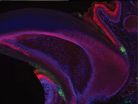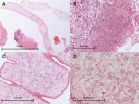Polyethylene mulch, glazing create optimal conditions for soil solarization
Study shows disinfection can occur in less than a week in high tunnels using recommended methods
2014-11-21
(Press-News.org) TUSCON, AZ - Soil solarization, a process that uses solar radiation to rid the soil of pests, is most common in regions with high solar radiation and high temperatures during the summer season. An alternative to soil fumigation, the process is used either alone or in combination with fumigants. To accomplish solarization, solar radiation is used to passively heat moist soil covered with clear plastic sheeting, with the goal of increasing soil temperatures to the point where they are lethal to soilborne organisms. The effectiveness of solarization is based on the actual maximum soil temperature reached and the amount of time the high temperatures can be sustained.
According to the authors of a study published in HortScience, the semiarid climate in southern Arizona is ideal for employing soil solarization. Ursula Schuch, advisor to former graduate student Kristen Hanson, said that June is the optimal time for solarization in the region because daily solar radiation and temperatures are higher in June than in any other month. Low relative humidity during early summer months, combined with high temperatures and high solar radiation, provides growers with opportunities to use solarization in high tunnels while their production beds are fallow.
Schuch, Hanson, and research specialist Tilak Mahato designed experiments to determine the efficacy of using clear polyethylene mulch on the soil surface inside high tunnels covered with clear polyethylene glazing to solarize the soil during the hottest time of the year. "One goal of the study was to provide growers using high tunnels in the semiarid Southwest with information that may be beneficial to protecting their crops from weed and other pest populations," Schuch said.
The experiments took place in two high tunnels in Tuscon. Polyethylene (PE) glazing was kept on each of the two high tunnels from late May through early June. Half of each of the growing beds was covered with solid, clear polyethylene mulch that contained an ultraviolet stabilizer that prevented degradation from solar radiation.
"We found that the most effective solarization strategy was to keep the glazing on the high tunnels in conjunction with a 25.4-mm PE cover on the well-irrigated beds," the authors wrote. "When daily solar radiation averaged 29.8 MJ•m-2 and outside temperatures reached 38 °C, the soil at 5-cm depth exceeded 45 and 55 °C for almost 15 hours and 8 hours, respectively, each day. This treatment resulted in a significant period each day when temperatures exceeded the thresholds to effectively kill many soil pathogens, pests, and weeds in a relatively short time." In the experiments, soil temperatures to 15-cm depth increased such that disinfestation for many undesirable organisms would be completed in less than 1 week.
The authors added that achieving soil solarization with PE mulch covering the soil without glazing on the high tunnels required a longer duration. The results also determined that solarization with glazing only on the high tunnel was least effective in raising soil temperatures.
INFORMATION:
The complete study and abstract are available on the ASHS HortScience electronic journal web site: http://hortsci.ashspublications.org/content/49/9/1165.abstract
Founded in 1903, the American Society for Horticultural Science (ASHS) is the largest organization dedicated to advancing all facets of horticultural research, education, and application. More information at ashs.org
[Attachments] See images for this press release:

ELSE PRESS RELEASES FROM THIS DATE:
2014-11-21
Quebec City, November 21, 2014--Scientists from Université Laval, the University of British Columbia and the University of Oxford have discovered a natural resistance gene against spruce budworm in the white spruce. The breakthrough, reported in The Plant Journal, paves the way to identifying and selecting naturally resistant trees to replant forests devastated by the destructive pest.
A research team composed of professors Éric Bauce, Joerg Bohlmann and John Mackay as well as their students and postdocs discovered the gene in spruces that had remained relatively ...
2014-11-21
Employees who work at small, locally owned businesses have the highest level of loyalty to their employers -- and for rural workers, size and ownership of their company figure even more into their commitment than job satisfaction does, according to Baylor University researchers.
Higher levels of commitment are associated with less absenteeism, lower turnover and less seeking of jobs outside the company. The study -- "Small, local and loyal: How firm attributes affect workers' organizational commitment" -- is published in the journal Local Economy.
"It's an interesting ...
2014-11-21
LA JOLLA, CA - November 20, 2014 - Scientists at The Scripps Research Institute (TSRI) have discovered how one gene is essential to hearing, uncovering a cause of deafness and suggesting new avenues for therapies.
The new study, published November 20 in the journal Neuron, shows how mutations in a gene called Tmie can cause deafness from birth. Underlining the critical nature of their findings, researchers were able to reintroduce the gene in mice and restore the process underpinning hearing.
"This raises hopes that we could, in principle, use gene-therapy approaches ...
2014-11-21
There are plenty of body parts that don't grow back when you lose them. Nails are an exception, and a new study published in the Proceedings of the National Academy of Sciences (PNAS) reveals some of the reasons why.
A team of USC Stem Cell researchers led by principal investigator Krzysztof Kobielak and co-first authors Yvonne Leung and Eve Kandyba has identified a new population of nail stem cells, which have the ability to either self-renew or undergo specialization or differentiation into multiple tissues.
To find these elusive stem cells, the team used a sophisticated ...
2014-11-21
Stress activates the immune system
The team focused mainly on a certain type of phagocytes, namely microglia. Under normal circumstances, they repair synapses between nerves cells in the brain and stimulate their growth. Once activated, however, microglia may damage nerve cells and trigger inflammation processes. The studies carried out in Bochum have shown that the more frequently microglia get triggered due to stress, the more they are inclined to remain in the destructive mode - a risk factor for mental diseases such as schizophrenia.
Susceptibility for stress effects ...
2014-11-21
A protein kinase or enzyme known as PKM2 has proven to control cell division, potentially providing a molecular basis for tumor diagnosis and treatment.
A study, led by Zhimin Lu, M.D., Ph.D., professor of neuro-oncology at The University of Texas MD Anderson Cancer Center, showcased the non-metabolic abilities of PKM2 (pyruvate kinase M2) in promoting tumor cell proliferation when cells produce more of the enzyme.
The study results were published in today's issue of Nature Communications.
Dr. Lu's group previously demonstrated that PKM2 controls gene expression ...
2014-11-21
Immunity is a thankless job. Though the army of cells known as the immune system continuously keeps us safe from a barrage of viruses, bacteria and even precancerous cells, we mainly notice it when something goes wrong: "Why did I get the flu this year even though I got vaccinated?" "Why does innocent pollen turn me into a red-eyed, sniffling mess?"
A new study from Johns Hopkins takes a big step toward answering this and other questions about immunity, shedding light on how the body recognizes enemies on the molecular level -- and how that process can go wrong. The results ...
2014-11-21
A genome of a rare species of tapeworm found living inside a patient's brain has been sequenced for the first time, in research published in the open access journal Genome Biology. The study provides insights into potential drug targets within the genome for future treatments.
Tapeworms are parasites that are most commonly found living in the gut, causing symptoms such as weakness, weight loss and abdominal pain. However, the larvae of some species of tapeworm are able to travel further afield to areas such as the eyes, the brain and spinal cord.
A 50-year-old man ...
2014-11-21
For the first time, the genome of a rarely seen tapeworm has been sequenced. The genetic information of this invasive parasite, which lived for four years in a UK resident's brain, offers new opportunities to diagnose and treat this invasive parasite.
The tapeworm, Spirometra erinaceieuropaei, has been reported only 300 times worldwide since 1953 and has never been seen before in the UK. The worm causes sparganosis: inflammation of the body's tissues in response to the parasite. When this occurs in the brain, it can cause seizures, memory loss and headaches. The worm's ...
2014-11-21
Current efforts to prevent violence against women and girls are inadequate, according to a new Series published in The Lancet. Estimates suggest that globally, 1 in 3 women has experienced either physical or sexual violence from their partner, and that 7% of women will experience sexual assault by a non-partner at some point in their lives.
Yet, despite increased global attention to violence perpetrated against women and girls, and recent advances in knowledge about how to tackle these abuses (Paper 1, Paper 3), levels of violence against women - including intimate ...
LAST 30 PRESS RELEASES:
[Press-News.org] Polyethylene mulch, glazing create optimal conditions for soil solarization
Study shows disinfection can occur in less than a week in high tunnels using recommended methods





